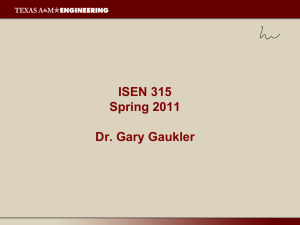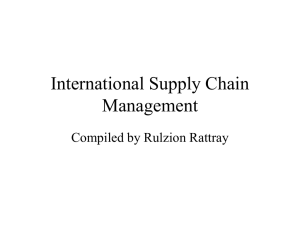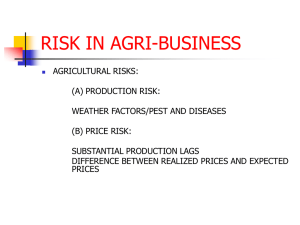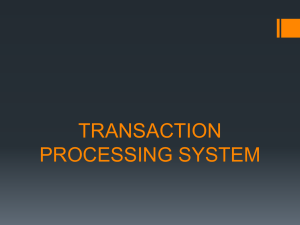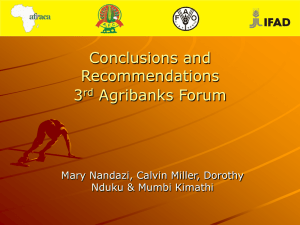Ch02TheRulesoftheGame_ez
advertisement
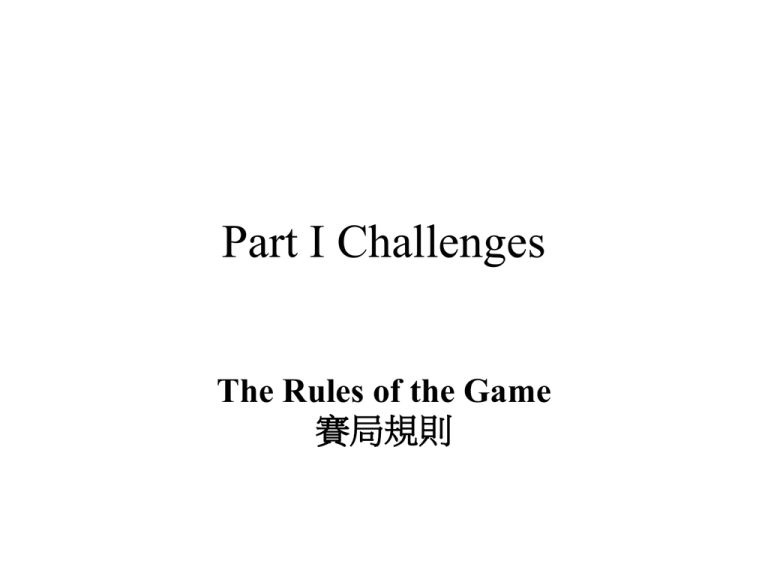
Part I Challenges The Rules of the Game 賽局規則 The Rules of the Game Supply chain management is a difficult game to master. It requires you to move a great many pieces in very specific ways, and you have to choreograph those moves to make each piece arrive in the right place at the right time. It's also a game that plays out on a grand scale, with a playing field that spans the entire planet. Fortunately, the rules of the game—the descriptions of the pieces and the ways they move—are simple enough to be summarized in a few pages. In a nutshell, supply chains consist of production and storage facilities Connected by transportation lanes, and they exist to support the flow of demand, supply, and cash. The difficulty of managing supply chains comes primarily from the complexity that creeps into their structure and the variability that characterizes their flows. It's this complexity and variability that make an easy game hard to master. 供應鏈管理是個不易精通的寶局(game)。它需要你以很特殊的方式移動很 多物品,而且你必須有效協調這些移動,便這些物品可以在對的時間 (right time)抵達對的地方(right place)。這種賽局的比賽場地範圍很大,涵 蓋全球。幸虧這種賽局的規則──物品的描述與移動的方式──很簡單, 可以摘要記錄在幾頁中。簡言之,供應鏈包括製造與儲存設施(production and storage facilities)及連結這些設施的運輸路線(transportation lanes),他 們存在之目的是要支援需求(demand)、供應(supply)與帳款(cash)的流程。 管理供應鏈的困難度主要源自其複雜性(complexity)──由結構(structure) 所產生,以及變異性(variability)──來自流量與流程(flows)特性。正是因 為這些複雜性與變異性,使得供應鏈這個看似單純的賽局很難加以精通。 Facilities and Links(設施與連結) A supply chain is a network of facilities A supply chain is basically a set of facilities connected by transportation lanes. Figure 2.1 illustrates one slice of the supply chain that brought you this book. Facilities,shown as rounded rectangles in the illustration, generally fall into one of two categories, depending on their primary function: production facilities and storage facilities. Transportation lanes, shown as arrows, are categorized by their mode of transportation; they include road ways, railways, waterways, sea lanes, air lanes, and pipelines. Viewed in the largest context, supply chains extend from the original extractors of raw materials, such as mines and farms, to the ultimate consumers of finished goods, the people who actually put those goods to their intended purpose. 一個供應鏈是由一些設施組成的一個網路 一個供應鏈(supply chain)基本上是由運輸路線所連結的一組設施。圖2.1舉 例說明將一本書由原料取得、生產到送至你手中的一個供應鏈。設施 (facilities),如圖2.1顯示的圓角方形通常有兩類,須根據它們的主要功能 而定,包含製造設施(production facilities)與儲存設施(Storage facilities)。 運輸路線(transportion lanes),如圖2.1顯示的箭頭,可由運輸模式(mode of transportation)加以區分,包括陸路(roadways)、鐵路(railways)、水路 (waterways)、海洋航線(sea lanes)、空中航線(air lanes)及管道(pipelines)。 從最寬廣的範圍來看,供應鏈從最源頭的物料採擷商(extractors),例如, 採礦場(mines)或農場(farms)延伸至最下游成品的消費者(consumers),那些 真正將物品拿來使用消費的人。 Facilities and Links(設施與連結) A supply chain is a network of facilities From Tree to Book Facilities and Links(設施與連結) Facilities contain inventories Facilities contain controlled quantities of materials called inventories (Figure 2.2). Production facilities hold inventory in three different forms: Raw materials inventory consists of materials ready for use in production; work-inprocess (WIP) inventory includes all the materials currently being worked on; and finished goods inventory holds completed products ready for shipment. Storage facilities vary: Warehouses usually contain only a single kind of inventory, but distribution centers that do final assembly contain all three kinds. Cross docks, which are used only to transfer goods between trucks, do not contain any separately managed inventory. Retail stores also vary in this regard: Custom bicycle shops have all three types of inventory, warehouse-style stores contain only one, and some appliance stores carry none at all. 設施中擺放的是存貨 設施申存放一定控制數量的物料,稱之為存貨(inventories),如圖2.2。製 造設施持有三種不同型態的存貨:原料存貨(raw materials inventory)包括 為製造準備的原料;在製品存貨(work-in-process (WIP) inventory)包括所有 製造過程中的物料;製成品存貨(finished goods inventory) 為已製成準備出 貨的製成品。儲存設施的類型有:倉庫(warehouses)通常僅存放單一類型 的存貨;不過有組裝功能的配銷中心(distribution centers)則包含上述三類 的存貨;越庫設施(cross docks),只用於貨車間的轉運,則不包含需管理 的庫內存貨。零售店存放的存貨類型也有幾種:客製化腳踏車店(custom bicycle shops)包含所有三類的存貨;倉庫型零售店(warehouse-style stores) 往往只持有一種類型;有些家電門市(appliance stores)則什麼存貨都沒放 Facilities and Links Facilities contain inventories Facilities and Links(設施與連結) Lanes are used by vehicles and containers Lanes are used to move inventory between facilities along a particular mode of transportation, using a combination of vehicles and containers. Some vehicles, such as truck tractors and railway engines, can be decoupled from their containers, whereas other vehicles, such as delivery vans and tanker ships, have the container built in. Decoupling is an important consideration because it offers more flexibility in routing, dispatching, temporary storage, and other transportation activities. In the case of pipelines, the functions of the vehicle and the container are merged with the lane itself, with pumps providing the motive force and pipes containing the inventory in transit. 路線是供運具與貨櫃使用 路線(lanes)乃於設施間使用特定運輸模式移動存貨之用,路線須綜合使用 運其及貨櫃。有些運具(vehicles),例如,卡車曳引車頭(truck tractors)及火 車頭(railway engines)可以與貨櫃容器(containers)分離(decoupling);但有些 運具,例如,配送小車(delivery vans)與油輪(tanker ships),其貨櫃與載運 容器則是構建在一起的。分離是一項重要考量,因為這類設計提供路線規 劃(routing)、人車調度(dispatching)、暫時性儲存(temporary storage)及其他 運輸活動更大的彈性。以管道運輸為例,運具及容器功能與路線合併在一 起,由幫浦(pumps)提供推進力,而管道中則包含了在途存貨(inventory in transit)。 Facilities and Links(設施與連結) Transportation modes offer tradeoffs Each mode of transportation offers a unique mix of speed, cost, availability, and capability. For example, shipping by air is fast, expensive, available from all large cities, and limited to small and lightweight packages. By contrast, shipping by sea is slow, cheap, available only at cities with ports, and virtually unlimited with regard to size and weight. There are also different volume tradeoffs within each mode. In trucking, it is much cheaper to send full truckload (FTL) shipments than it is to use less-than-truckload (LTL) shipments, and the FTL option offers tighter control over the routing and timing of the shipment. However, using FTL shipments requires building up more finished goods inventory and may cause delays in shipments. Similar tradeoffs apply in the other modes. 運輸模式間其互抵效應 每種運輸模式均提供該模式速度(speed)、成本(cost)、供應力(availability) 及能力(capability)之特有組合。例如,採用航空運輸的特性是快速(fast)、 昂貴(expensive)、在主要大城市都有供應(avail-able from all large cities), 且僅適用體積小(small)、重量輕(light-weight)的包裝物。相對地,海運的 特性是速度慢(slow)、便宜(cheap)、只在有海港的都市有供應(available only at cities with ports),而且對於物品的體積(size)及重量(weight)幾乎全 無限制(unlimited),每種運輸模式間也存在數量上的互抵效應(tradeoffs)。 對於汽車貨運而言,整車運輸(full truckload, FTL)相較於零擔運輸(lessthan-truck-Load, LTL)便宜許多,而且整車運輸在貨物運送的路線與時間 安排上有更嚴格的管控。不過,使用整車運輸需要匯集較多的商品數量, 因而有可能造成運送的延誤。相似的互抵效應也存在於其他的運輸模式中 Facilities and Links(設施與連結) Shipments can use multiple modes Shipping within a limited geographical region normally uses a single mode from source to destination. For larger distances, including most international trade, shipments generally use two or more modes, a practice known as intermodal transportation. For example, a shipment might travel by rail to the nearest seaport, cross the ocean by ship, and travel the rest of the way by truck. Inter-modal shipments are usually enclosed in steel cargo containers that can be transferred between specially fitted rail cars, container ships, and tractortrailers. 運輸貨件可以使用多種運輸模式 在一有限地理區域上運送貨物,通常採用單一運輸模式從起運點送至目的 地。對較為長途的運輸,包括多數的國際貿易,運輸貨件通常使用兩種以 上的運輸模式,即眾所周知的複合運輸(inter-modal transportation)。例 如,一個貨件可能先由火車送到最近的海港,再由船舶載越海洋,最後由 卡車送抵目的地。複合運輸貨件通常裝入於鐵製貨櫃容器內,可在設計有 易於轉換貨櫃的鐵路列車、貨櫃船及貨櫃拖車間轉運。 Facilities and Links(設施與連結) Lanes contain inventory in transit Like facilities, transportation lanes contain inventory. This in-transit Inventory bridges the gap between the shipping facility's finished goods inventory and the receiving facility's raw materials inventory (Figure 2.3). Intransit inventory is different from other forms in that it is unavailable for use, is at higher risk of loss from theft and accidents, and is subject to delays due to vehicle breakdown and lane congestion. Along with raw materials, work in process, and finished goods, in-transit inventory represents the fourth Major type of inventory. 運輸路線中的貨物為在途存貨 如同設施一般,運輸路線也包含存貨。在途存貨(in-transit in-ventory)銜 接了出貨設施端成品存貨(shipping facility‘s finished goods inventory)及進 貨設施端原料存貨(receiving facility‘s raw materials inventory)間之落差 (如圖2.3)。在途存貨與其他類型的存貨不同,因為它無法使用 (unavailable for use)、有較高失竊及意外損失的風險(higher risk of loss from theft and accidents),以及起因於車輛故障與路線壅塞造成的延誤 (delays due to vehicle breakdown and lane congestion)。除了原物料(raw materials)、在製品(work-in-process)、製成品(finished goods)這三類存貨 外,在途存貨成為第四種主要的存貨類型。 Facilities and Links(設施與連結) Lanes contain inventory in transit Facilities and Links(設施與連結) Containers are often used for storage The distinction between in-transit inventory and the two inventories it connects is often blurred in practice. Trailers or railcars are frequently used to store finished goods at production facilities Until full loads are produced, in which case the goods are still part of the plant's finished goods inventory. But if the storage is brief and the destination of the goods is determined by the choice of containers, the goods in the container may be treated as inventory in transit as soon as they are loaded. Similar issues come up at the destination, where full containers may sit for days or weeks in a yard before being unloaded. In one rather perverse practice, railway cars are actually kept on the move, circling in wide arcs around a facility, until there is space to park them in the yard. This is a very expensive way to hold inventory. 貨櫃常作為儲存用途 在途存貨與其相關兩類存貨間之區別在實務上常易生混淆。拖車或火車廂 常於生產設施用來儲存製成品,等裝滿後再運送出廠。此時,裝車貨物仍 屬工廠的製成品存貨。不過假如儲存時間很短,而且貨物目的地是取決於 貨櫃的選擇時,貨物一旦裝入貨櫃內即可視為在途存貨。在目的地也有相 類似的狀況,重櫃(loaded containers)可能在櫃場坐等數日後才開始卸櫃。 有一種非常不當的做法,火車列車持續行駛,繞著一個設施轉,直到有停 車月台後才停下來。 Facilities and Links(設施與連結) Package carriers are viewed as a mode Although they don't make use of a separate transportation medium, package Carriers such as UPS and FedEx are commonly viewed as a distinct mode when making transportation decisions. In reality, these carriers use a mix of air and highway transport to deliver their packages, using their own fleets of aircraft and trucks. As a practical matter, however, it doesn't matter how a package is conveyed because that decision is out of the shipper's hands, so using a package carrier is viewed as an alternative on a par with shipping by air, land, or water. The tradeoffs discussed for the other modes also apply to package carriers: They are fast, relatively expensive, available in most locations, and limited to relatively small, lightweight products. 包裹運輸業被視為一種運輸模式 儘管不僅採用一種運輸媒介,包裹運輸業者(package carriers),如UPS或聯 邦快遞(Federal Express, FedEx),通常也被視為運輸決策時運輸模式的選 擇之一。事實上,這類包裹運輸業者(carriers)使用空中與路面運輸組合方 式配送承運包裹,使用的是自己的機隊與卡車。務實點來看,貨主並不在 乎包裹究竟是怎麼運送的,因為這不是他可以決定的。因此,使用包裹運 輸業者被視為與選擇其他空運、陸運或海運運輸模式一般之另一種選擇。 前面討論過的模式互抵效應也適用於包裹運輸業者:其特性為快速、相對 較昂貴、多數地點有提供服務,並且侷限於體積較小、重量較輕的產品。 Demand, Supply, and Cash(需求、供應及帳款) The best goal is an orderly flow of goods The essential goal in managing a supply chain is to achieve an orderly flow of goods from extractors to consumers. It should not be surprising, then, that the deepest roots of the discipline can be found in transportation management, which is responsible for moving finished goods to the next link in the chain. Over time, transportation management merged with a related function, materials management, to form the broader discipline of logistics, which handles the flow of materials all the way from suppliers through the three internal inventories and out to customers.. 基本目標是有序的物品流程 管理一個供應鏈的必要目標在於,追求自採擷商(extractors)至消費者間有 序的物品流程。所以我們應不至驚訝於發現供應鏈管理這個專業領域的一 個深根(deepest roots)係來自於運輸管理,負責移送製成品於運輸連結間。 經時間演變,運輸管理合併了一個相關機能──物料管理(materials management),形成一個更寬廣的物流專業(discipline of logistics),處理來 自於供應商的原料,經過三種內部存貨再送到消費者的整個物料流程。 Demand, Supply, and Cash(需求、供應及帳款) Demand and cash flow are equally important Three Basic Flow Demand, Supply, and Cash(需求、供應及帳款) Demand and cash flow are equally important What distinguishes the current discipline of supply chain management (SCM) from its predecessors is that it is equally concerned with two other flows: the flow of demand and the flow of cash up the chain, as shown in Figure 2.4. Without these other flows, the goods would never move: It's demand that provides the impetus for that movement, and it's cash that provides the motivation. The great insight of supply chain management is that the key to managing the flow of goods effectively lies in synchronizing all three flows. This synchronization becomes particularly difficult when, as shown in the "stack" notation in Figure 2.4, there can be any number of organizations at each link of the chain. 需求與帳務(金錢)流程一樣重要 現在的供應鏈管理(supply chain management, SCM)與其前身之主要區分是 供應鏈管理對另兩個流程給予相同的重視,如圖2.4所示:由下向上的需 求流程(demand flow)與帳款流程(cash flow)。如果沒有這兩個流程,商品 根本無法移動:需求提供了移動的原動力,而金錢(帳款)則提供了誘因。 供應鏈管理最偉大的洞察力是:有效管理物品流程的關鍵在於取得三個流 程的同步化(synchronization)。如圖2.4顯示的堆疊方塊,當供應鏈上的每 一連結均有很多組織時,同步化變得特別的困難。 Demand, Supply, and Cash(需求、供應及帳款) The Basic dynamics of the flows are simple The basic operation of a supply chain could hardly be simpler. Demand flows up the chain and triggers the movement of supply back down the chain. As supplies reach their destinations, cash flows up the chain and compensates suppliers for their goods. Naturally, the behavior of real-world supply chains is never quite this simple. But recognizing the fundamental elegance of supply chain dynamics provides the best foundation for understanding the complexities that inevitably arise. 流程間的基本動態關係很單純 一個供應鏈的基本作業(basic operations)非常簡單。需求(demand 往供應鏈 上游流動,並啟動供應物品(supplies)往下游移動。當供應物品抵達目的地 後,金錢(cash)即往上游移動,並支付供應商(suppliers)的貨款。當然,真 實世界供應鏈的行為沒有這麼單純。不過,認識供應鏈動態特性的基本原 理提供了進一步瞭解實際複雜度一個非常好的基礎。 Demand, Supply, and Cash(需求、供應及帳款) Flows are discrete rather than continuous With a few exceptions, such as oil moving through a pipeline, the three flows in a supply chain are discrete rather than continuous. That is, they move in distinct "packets" that convey particular quantities at particular times. Demand is normally conveyed through orders, supply through shipments, and cash through payments (Figure 2.5). A great deal of supply chain management is concerned with balancing the tradeoffs between the size and the frequency of these packets. For example, economies of scale favor infrequent orders of large quantities of material, whereas reducing Inventory carrying costs requires more frequent shipments of smaller quantities. For any given rate of flow, the smaller the packets become, the closer the chain comes to operating as a continuous flow rather than moving discrete lumps of demand, supply, and cash across the chain. 流程是離散的而非連續的 除了少數例外,如石油在管道中移動,供應鏈中的三個流程屬離散型態的 (discrete)而非連續型態的(continuous)。亦即,各個流程以特定封包 (packets)移動,在特定時間承載特定數量的物品。需求一般透過訂單 (orders)傳送,供應(supply)透過貨件運送(shipments),而帳款(cash)透過付 款作業(payments)清償(如圖2.5)。供應鏈管理的許多工作是關於在這些封 包的大小(size)與頻率(frequency)之互抵效應上求得平衡。例如,經濟規模 之著重將偏好大量物料的低頻率購買,然而降低存貨持有成本之著重則需 要高頻率的少量進貨。對一固定的流程速率(rate of flow),當封包變得愈 小,供應鏈愈趨近於連續流程;反之,則趨近於離散流程。 Demand, Supply, and Cash(需求、供應及帳款) Flows are discrete rather than continuous Demand, Supply, and Cash(需求、供應及帳款) Each exchange has a customer and supplier As Figure 2.5 illustrates, each exchange of demand, supply, or cash takes place between a customer and a supplier. In this book, these terms refer to the parties involved in a transaction across any link of the chain, regardless of their location within the chain. In other words, I use the terms in a relative rather than an absolute sense, the way the terms buyer and seller are used in discussing a purchase. This is a common usage for these terms but it's not universal; many writers use the term customer to refer to the ultimate consumer of the goods, and others use the term supplier only for upstream members of the chain who provide basic materials or assemblies. I avoid confusion in this book by always using the terms in the relative sense, but you should be aware of the inconsistent usage in other discussions. Be particularly alert to the differences in the way various authors use the terms customer and consumer, the muddling of these concepts often leads to pointless diatribes about who the "real" customer is. 每次交易均涉及一位顧客及一位供應商 如圖2.5所例示,需求、供應及帳款的每次交易(exchange)均會在一個顧客 (customer)及一個供應商(supplier)間發生。在本書中,這兩個用語指的是 在供應鏈任何連結(link)上進行交易的成員,而不管他們座落於供應鏈上 的哪個地點。換句話說,作者使用的用語具相對性概念而非絕對性,誠如 採購上使用採購人員(buyer)與銷售人員(seller)般。上述用語是通常的用法 但並不其有普世性:許多作者將顧客一語用於指最終消費者,而也有些作 者將供應商一語純粹用來表示提供原物料的供應鏈最上游廠商。本書對顧 客與供應商這兩個用語乃採相對概念用法以避免混淆,不過讀者需要注意 在其他討論(或書籍)中的不一致性。更須特別注意好幾位作者使用顧客 (customer)及消費者(consumer)這兩個名詞時的差異所在;這些觀念的混淆 常造成到底誰才是「真」的顧客的無謂爭議。 Demand, Supply, and Cash(需求、供應及帳款) Production may be to stock or to order Orders trigger the flow of goods, but, depending on the production strategy, they may or may not trigger their immediate production by a supplier (Figure 2.6). In the make-to-stock strategy, a supplier makes products in advance of demand and holds them in finished goods inventory, satisfying demand from that inventory as orders come in. In the make-to-order strategy, the supplier doesn't build a product until it has an order in hand. There is also an intermediate strategy, assemble-to-order, in which a product is partially built in advance of demand, but final assembly is postponed until an order is received. Some companies use a mix of these three techniques, but choose one as their primary strategy. For example. Sony uses make-to-stock, Boeing uses make-to-order, and Dell uses assemble-to-order. 生產可能採庫存或訂購模式 訂單會啟動物品的流動,但是取決於生產策略型態,訂單可能或不一定會 啟動供應商的立即生產(如圖2.6)。依據庫存生產策略(make-to-stock strategy),供應商在需求發生前即將產品製造出來,並持有這些製成品存 貨來滿足訂單需求。依據接單生產策略(make-to-order strategy),供應商接 到訂單後才會生產。還有一種介於中間的策略──組裝生產(assemble-toorder),先將產品的部分在需求前生產出來,產品的最後組裝延遲至接到 訂單後再完成。許多公司將上述三種策略交叉使用,但是選擇其一為主要 策略。例如,新力(Sony)採用庫存生產、波音(Boeing)使用接單生產、戴 爾公司(Dell)則採用組裝生產。 Demand, Supply, and Cash(需求、供應及帳款) Production may be to stock or to order Demand, Supply, and Cash(需求、供應及帳款) Production type determines push-pull strategy The choice of production strategy has a major impact on the dynamics of a supply chain. With the classic make-to-stock strategy, inventory is produced in advance of and "pushed" down the chain toward consumers so that it will be on hand when they go to buy it. This strategy relies on demand forecasts to determine how much inventory to build and where to hold it. With make-toorder production, inventory is "pulled" down the chain by immediate orders. Forecasts are less important with make-to-order because there is no danger of making too much or too little inventory, though long-term forecasts are important to setting the correct levels of manufacturing capacity. 生產型態決定其推拉策略 生產策略的選擇對供應鏈的動態性產生關鍵的影響。在典型庫存生產策略 中,庫存被預先生產出來並從供應鏈向下「推」(push)往顧客端,因此, 當顧客要去購買時隨手可得。這項策略仰賴需求預測來決定要取得多少存 貨及在何處持有。在接單生產策略中,存貨是被即時性訂單「拉」(pull) 向供應鏈的下游。對於接單生產策略而言,需求預測較不重要,因為它沒 有由產過剩或不足的風險,重要的是透過長期的預測來建立正確的產能水 準。 Demand, Supply, and Cash(需求、供應及帳款) Every chain has push and pull segments These dynamics are often used to characterize supply chains as either push chains or pull chains, but in reality every chain is a mixture of push and pull. As long as consumers have a choice about what products they buy and when they buy them, the last link in the chain is always a pull link. At the other end of the chain, the extraction of raw materials from the earth almost always occurs in advance of demand for finished products. In effect, consumers pull and extractors push. Somewhere in between the two is the push-pull boundary (Figure 2.7), the point at which the flow of goods switches from being pulled by consumers to being pushed by extractors. In the case of the assemble-to-order strategy, for example, the push-pull boundary is located at the final assembly plant. 每個供應鏈都有推與拉的區段 這些生產上的動態性,通常被用來區分供應鏈究竟屬「推式供應鏈」 (push chains)或是「拉式供應鏈」(pull chains),但是實際上,每個供應鏈 都是推與拉的混合體。只要消費者在購買時對產品種類及時間可以選擇, 在供應鏈中最後一個連結必定是一個拉式連結(a pull link)。在供應鏈的另 一端,從地面將原料採擷出來的工作幾乎都是在製成品需求前發生。實際 上,供應鏈中消費者會拉而原料採擷商會推,介乎兩者之間就是所謂的 「推拉邊界」(push-pull boundary)(圖2.7),在這個臨界點物品流動從消費 者的拉力轉換為採擷商的推力。在組裝生產策略的案例中,推拉邊界就位 於最終裝配工廠。 Demand, Supply, and Cash(需求、供應及帳款) Any link can be push or pull Boundary Actually, the push-pull distinction applies to every link in the chain, so it's possible for any link to operate in pull mode even though it is up in the push region of the chain. Ford's supply chain is a push chain right down to the dealer showroom, but it contains many links that are pure pull. For example, Johnson Controls builds a seat from raw materials and delivers it to Ford within four hours of receiving an order, allowing the company to supply seats to Ford based on firm orders for specific configurations. In the context of a massive supply chain involving tens of thousands of companies building against anticipated demand, Johnson Controls is able to supply this particular component on a pull basis. 任何連結可以是推或拉 事實上,推一拉的區分適用在供應鏈中的每個連結,因此,有可能即使是 在供應鏈的推式區段裡也可以採用拉式作業。福特汽車(Ford)的供應鏈從 上游一直到汽車展示場都是推式供應鏈,但是其中仍包含許多純粹拉式的 連結。例如,Johnson Controls這家公司可以在接到一張訂單的4小時內, 將原料生產成汽車座椅並配送到組裝廠,使公司可以根據各式特殊型態規 格的確定訂單供應座椅給福特汽車(Ford)在涉及數萬家公司且是採取推測 需求策略的一個龐大供應鏈環境下,Johnson Controls仍能以拉式基礎來供 應這項特定的零組件。 Demand, Supply, and Cash(需求、供應及帳款) Any link can be push or pull Boundary The Push-Pull Boundary Demand, Supply, and Cash(需求、供應及帳款) Cash flow receives the least attention Of the three primary flows in supply chains, cash flow is the one that receives the least attention. This is understandable: Supply chains exist to move products to consumers, and orders are the mechanism for triggering that movement. But cash is the ultimate driver for the entire process; take it out of the equation and the whole business would come to a halt pretty quickly. Yet cash flow performance is the worst of the three, with producers routinely taking months to pay suppliers for goods that were shipped within days of being ordered. This situation is now changing, and accelerating the flow of cash is coming to be recognized as a key element of supply chain excellence. 帳務流程得到最少的關注 在供應鏈三個主要的流程中,帳款流程(cash flow)是受到最少關注的一 個。這其實是可以理解的:供應鏈之存在就是要將產品移動到消費者手 中,而訂單是啟動這個移動的機制。但是金錢(帳務)是整個程序的最終驅 動力;如果將金錢從方程式中除去,整個商業活動將很快完全停頓下來。 然而帳款流程的績效卻是這三個流程中最糟糕的,生產商經常跟供應商訂 貨並要求幾天內交貨,但卻好幾個月後才支付貨款。這樣的狀況現在已經 有所改變,並且加速帳款流程已經逐漸被視為是供應鏈卓越績效的關鍵要 素。 Demand, Supply, and Cash(需求、供應及帳款) Information also moves across the chain In addition to the three key flows, there is something else that moves across the chain: information. Actually, information is already implicit in the three flows: Orders represent information about immediate demand, some products can be transmitted as information, and even cash can be exchanged in the form of information. But the more interesting kind of information isn't part of the actual transactions—it is exchanged in order to facilitate those transactions. This information includes demand forecasts, production plans, promotion announcements, and reports of all kinds. Unlike the three basic flows, information can move across the chain at any time, without being part of a particular transaction, and it isn't constrained to move sequentially up or down the chain. Instead, it can be broadcast simultaneously to any subset of the chain, ensuring that they are all operating with the same information at the same time (Figure 2.8). 資訊也同樣在供應鏈中流動 除了這三項主要流程,還有一樣東西也在供應鏈中流動──資訊 (information)。事實上,資訊已經內含在這三項流程之中:訂單代表立即 性需求的資訊,有些產品可以以資訊的方式傳遞,甚至帳務也可以透過資 訊的形式交換。但是更有趣的資訊類型並非實際交易的一部分──這些資 訊的交換是為了促進交易活動。這類資訊包括需求預測(demand forecasts)、生產計畫(production plans)、促銷宣傳(promotion announcements)以及各種的報告(reports of all kinds)。與供應鏈三個基本流 程不同的是,資訊可以於任何時間在供應鏈中移動,無須是特定交易的一 部分,並且不限於在供應鏈中向上或向下做序次性移動(move sequentially)。取而代之的是,資訊能夠同時散播至每一個供應鏈的子集 合,確保這些供應鏈成員在相同時間以相同資訊在工作(如圖2.8)。 Demand, Supply, and Cash(需求、供應及帳款) Information also moves across the chain Demand, Supply, and Cash(需求、供應及帳款) Information can replace inventory One of the great insights into the behavior of supply chains is that information can often be substituted for inventory. Instead of requiring every member of the chain to maintain safety stock to buffer against uncertainty in demand, that uncertainty can be reduced by sharing information that helps members anticipate coming changes in the flows of demand, supply, and cash. Information is usually far cheaper than inventory, and it has the advantage that it can be in many places at the same time. The result: Substituting Information for inventory is a key technique for improving supply chain performance and will be a continuing theme of this book. 資訊可以取代存貨 對於供應鏈行為的一個重要洞見(great insight)就是,資訊經常可以取代存 貨。取代要求供應鏈每位成員維持安全存貨(safety stock)來緩衝需求的不 確定性,這些不確定性可以藉由資訊分享幫助供應鏈成員預測需求、供應 及帳款流程的未來變化,進而降低。資訊成本通常遠低於存貨成本,並且 其有同時傳遞至多處的優勢。結論是:以資訊替代存貨(information replaces inventory)是一項改善供應鏈績效的核心技術,同時也是本書將持 續探討的主題。 Distribution and Procurement(配銷與採購) Patterns make chains easier to understand Although the basic elements of supply chains can be combined in an infinite variety of ways, there are two basic patterns that account for most of the structure. To see these patterns, consider how a supply chain looks from the perspective of a single plant. Every facility downstream of that plant is a destination for its finished goods and forms part of the plant's distribution network. Every facility upstream is a source of supplies, and forms part of Its procurement network. These two networks of the supply chain are radically different from the plant's perspective. 型態讓供應鏈較易於理解 雖然供應鏈的基本元素能夠以無窮不同方式組合,但大部分結構屬於兩種 基本型態。為瞭解這些型態,試以單一工廠角度思考供應鏈的長相。工廠 下游的每個設施是製成品的配送點,並形成這家工廠配銷網路(distribution network)的一部分。工廠上游的每個設施是供應產品的一個來源並形成工 廠採購網路(procurement network)的一部分。從工廠角度來看,供應鏈中 這兩種網路截然不同。 Distribution and Procurement(配銷與採購) Destinations are grouped Into echelons Some plants ship only to a single destination, but this is rare. The normal pattern is for each plant to serve as many destinations as necessary to satisfy demand within a particular geographical region. These destinations, in turn, may ship the goods onward to still more destinations, and so on, until the products eventually reach their ultimate consumers (Figure 2.9). The successive layers of this supply chain pattern are commonly referred to as echelons, and they are numbered outward from the plant as shown In Figure 2.9. 配送點被群集成不同的層級 有些工廠只出貨到單一配送點,但是這比較少見。一般型態是每一個工廠 需要滿足指定服務地理區域範圍裡的所有需求。這些配送點也許又將產品 往下送到更多的配送點,以此類推,直到產品最後到達最終消費者的手中 (如圖2.9)。這個供應鏈型態中的連續階層(successive layers)通常被稱之為 「層級」(echelons),並且他們從工廠往外被依序編號,如圖2.9所示。 Distribution and Procurement(配銷與採購) Destinations are grouped Into echelons Echelons in Distribution Distribution and Procurement(配銷與採購) This pattern is a distribution network The business problem addressed by this portion of a supply chain is distribution, which is basically a matter of choreographing the flow of finished goods from the plant to consumers in a way that satisfies demand in a cost-effective manner. When multiple echelons are under the control of a single company, distribution managers often try to maintain an orderly distribution network by using only the links shown in Figure 2.9; that is, shipments are not normally allowed to skip echelons, and each destination receives shipments from only one facility in the echelon above it. Although these constraints simplify the management of a distribution network, they do not produce the most costeffective solutions. Constraints on distribution patterns are now being relaxed as more sophisticated tools become available for designing and operating distribution systems. 這類型態就是配銷網路 供應鏈的這個部分涉及的商業活動即為配銷(distribution),主要是以其成 本效益的方式協調從工廠到消費者之間的製成品流程,來滿足需求。當多 個層級由單一公司所掌控時,配銷主管通常會嘗試維持一個有秩序的配送 網路,僅採用圖2.9所示的連結;亦即,貨件配送(shipments)不允許跨越層 級,而且每個配銷點只能接受上一層級中的一個設施送來的貨件。雖然這 些限制可使配銷網路易於管理,然而這卻不是最具成本效益的方法。因為 設計並操作配銷系統的更精密工具已經被發展出來,配銷型態的限制條件 目前已逐漸降低。 Distribution and Procurement(配銷與採購) Distribution is harder with more destinations As you might expect, the difficulty of managing distribution goes up dramatically as the number of destinations increases. With more facilities to serve, the available inventory has to be divided more finely, increasing the risk of not having the right amount of product at any one facility. In addition, the time and expense of handling the goods increases with each echelon. On the other hand, transportation costs go down with more Echelons because products can travel much of the distance in larger, more economical shipments.Finding the right balance between these opposing forces is one of the key tradeoffs in distribution design. 配銷點愈多、配銷愈困難 一如預期的,管理配銷作業的困難度隨著配送點的增加而大幅度地提高。 當需要服務的設施愈多時,可用存貨就必須愈精細的分配,也增加了任一 設施沒有適當存貨配量的風險。此外,處理產品的時間與費用也隨著層級 的增加而增加。另一方面,配銷層級愈多,運輸成本會愈低,因為產品運 送多半能夠以較大量、經濟的貨件運送。找出這兩個對立力量間的適當平 衡點,是配銷網路設計的一個關鍵考量。 Distribution and Procurement(配銷與採購) Source facilities are grouped Into tiers Looking upstream, just the opposite pattern is observed. Although it is possible for a plant to obtain all of its supplies from a single source, this rarely happens. Ordinarily, the plant receives supplies from multiple sources, each of which receives its supplies from multiple sources, and so on, up to the point where the raw materials are obtained directly from extractors (Figure 2.10). The successive layers of this supply chain pattern are called tiers. Like echelons, tiers are numbered outward from the plant. 來源設施被群集成不同的階級 往工廠上游觀察,可看到剛好相反的型態。雖然有可能一家工廠只從單一 來源取得所有的供應貨源,然而這是較罕見的。通常一家工廠會接受多重 的供應來源,每一個供應點也會接受更上游多重的供應來源,以此類推, 最頂端是直接取得原料的採擷商(如圖2.10)。這個供應鏈型態中的連續階 層被稱為「階級」(tiers)。如同配銷網路層級般,採購網路階級也是從工 廠往上游依序編號。 Distribution and Procurement(配銷與採購) Source facilities are grouped Into tiers Looking upstream, just the opposite pattern is observed. Although it is possible for a plant to obtain all of its supplies from a single source, this rarely happens. Ordinarily, the plant receives supplies from multiple sources, each of which receives its supplies from multiple sources, and so on, up to the point where the raw materials are obtained directly from extractors (Figure 2.10). The successive layers of this supply chain pattern are called tiers. Like echelons, tiers are numbered outward from the plant. 這個型態是一個採購網路 由供應鏈這個部分所支援的企業功能是採購(procurement),它涉及採用即 時與貝成本效益的方法,協調原料與半製品從供應商到工廠之間的相關工 作。如圖2.10所示,採購網路通常比配銷網路較無秩序,重疊來源 (overlapping sources)是個常規而非例外。 Distribution and Procurement(配銷與採購) Source facilities are grouped Into tiers Distribution and Procurement(配銷與採購) This pattern is a procurement network The business function supported by this portion of a supply chain is procurement, which involves choreographing the flow of raw materials and subassemblies from their suppliers to the plant in a timely, cost-effective manner. As shown in the illustration, procurement networks tend to be less orderly than distribution networks, with overlapping sources being the rule rather than the exception. 這個型態是一個採購網路 由供應鏈這個部分所支援的企業功能是採購(procurement),它涉及採用即 時與貝成本效益的方法,協調原料與半製品從供應商到工廠之間的相關工 作。如圖2.10所示,採購網路通常比配銷網路較無秩序,重疊來源 (overlapping sources)是個常規而非例外。 Distribution and Procurement(配銷與採購) Procurement is harder with more sources Like distribution, procurement becomes more difficult to manage as the number of sources increases. The essence of successful procurement is having everything arrive as close to a production date as possible without paying more than is necessary to achieve that end. Simply by the laws of chance, the more suppliers involved, the more likely it is that at least one of them will’ miss its delivery date and delay a production run. In addition, the cost of placing orders and making payments goes up with the number of suppliers, as does the overhead of managing the additional relationships. As with echelons on the distribution side, adding tiers on the procurement side also increases the total time and expense required to bring production materials to the plant. 愈多來源採購愈困難 跟配銷管理一樣,當供應來源數目愈多,採購的困難度就愈高。成功採購 的本質是安排所有物料在愈接近生產日期前送達,而無須支付過多不必要 的成本。單純從機率法則來看,供應商愈多,愈可能有供應商錯失配送日 期而造成生產延誤。此外,下單採購與付款的成本隨著供應商數目的增加 而增加,管理額外供應商關係的間接費用也會增加。與配銷網路之層級 (echelons)一樣,增加採購網路的階級(tiers)也同樣會增加將原物料送到工 廠的總時間及費用。 Distribution and Procurement(配銷與採購) This pattern overlap extensively The basic distribution and procurement patterns described in this section can take on a wide variety of configurations. Most important, the sources and destinations may themselves be plants, each of which has its own distribution and procurement network. When there are multiple layers of plants, the distribution and procurement patterns overlap and the distinction Between them blurs. For any one plant, the picture is reasonably clear, but for the supply chain as a whole, it can become quite complicated. 這些型態重疊得非常厲害 本節描述的基本配銷與採購型態可以有多種不同的結構。最重要的是,這 些來源與配送點可以都是工廠,每個工廠都有自己的配銷及採購網路。當 工廠有好幾個階層時,配銷及採購型態將會重疊,而兩者間的區分將更為 模糊。對任一工廠而言,兩種網路型態圖像是相當地清晰;但是就整個供 應鏈來看,網路圖像可能會變得相當複雜。 Distribution and Procurement(配銷與採購) Ownership boundaries affect the flows An important consideration in analyzing supply chains is identifying ownership boundaries. A sequence of facilities owned by the same company makes up its internal supply chain, and the links outside of the ownership boundary are its external supply chain (Figure 2.11). Internal supply chains often run more smoothly than external chains because they can be centrally controlled, and no buying and selling are required to move the goods. One of the big advantages of the classic strategy of vertical integration, in which a single company owns as much of the supply chain as it can acquire, is that it pits an internal supply chain against the competition's harder-to-manage external chains. 所有權的邊界影響相關流程 在分析供應鏈時,有一項重要考量即是確認所有權的邊界。由同一家公司 擁有的一系列設施組成了「內部供應鏈」(internal supply chain),而所有權 邊界以外的連結就是這家公司的「外部供應鏈」(external supply chain)(圖 2.11)。內部供應鏈的經營通常較外部供應鏈平順,因為內部供應鏈能由 中央控制,無須經由買賣方式移動物品。傳統垂直整合策略(vertical integration)──一家企業擁有供應鏈中盡量多設施的策略──的一項優 勢,就是企業可以用內部供應鏈來對抗競爭對手較難管理的外部供應鏈。 Distribution and Procurement(配銷與採購) Ownership boundaries affect the flows An important consideration in analyzing supply chains is identifying ownership boundaries. A sequence of facilities owned by the same company makes up its internal supply chain, and the links outside of the ownership boundary are its external supply chain (Figure 2.11). Internal supply chains often run more smoothly than external chains because they can be centrally controlled, and no buying and selling are required to move the goods. One of the big advantages of the classic strategy of vertical integration, in which a single company owns as much of the supply chain as it can acquire, is that it pits an internal supply chain against the competition's harder-to-manage external chains. 所有權的邊界影響相關流程 在分析供應鏈時,有一項重要考量即是確認所有權的邊界。由同一家公司 擁有的一系列設施組成了「內部供應鏈」(internal supply chain),而所有權 邊界以外的連結就是這家公司的「外部供應鏈」(external supply chain)(圖 2.11)。內部供應鏈的經營通常較外部供應鏈平順,因為內部供應鏈能由 中央控制,無須經由買賣方式移動物品。傳統垂直整合策略(vertical integration)──一家企業擁有供應鏈中盡量多設施的策略──的一項優 勢,就是企業可以用內部供應鏈來對抗競爭對手較難管理的外部供應鏈。 Distribution and Procurement(配銷與採購) Ownership boundaries affect the flows Complexity and Variability(複雜性與變異性) Complexity and variability are key concerns The basic elements of supply chains—the structures, dynamics, and patterns described in the preceding sections—are simple. Yet, as illustrated by the examples in Chapter 1, real-world supply chains are notoriously difficult to manage, and they are liable to catastrophic failure. This contrast between principle and practice invites a crucial question: Where does the difficulty come from? Underneath the many symptoms and their immediate causes, there appear to be two root causes to the difficulty of managing supply chains: complexity and variability. This last section of the chapter takes the measure of each. 複雜性和變異性是主要考量 供應鏈的基本元素(basic elements)──結構(structure)、動態性(dynamics) 及型態(patterns),前述各節之重點──是很單純的。不過,如第1章案例 之說明,在真實世界中供應鏈是出了名的難以管理,並且容易導致災難性 的失敗。在原理與實務間的落差帶出一個重要問題:困難度究竟從何而 來?在許多症狀及它們所造成的表面原因之後,似乎存在兩個難以管理供 應鏈的根本原因(root causes):複雜性(complexity)與變異性(variability)。 本章最後一節即針對此兩個因素進行評析。 Complexity and Variability(複雜性與變異性) Supply chain flows are linked in complex ways The complexity begins with the way the three primary flows relate to one another. In principle, it's simple—orders trigger shipments,and shipments trigger payments. In practice, the relationship of orders to shipments and payments quickly becomes tortuous (Figure 2.12). A single production run generates orders to many different suppliers, and these orders are usually combined with orders for other production runs to achieve economies of scale in purchasing.The shipments fulfilling these orders may further combine orders to reduce the cost of transportation, but large orders may also be split across two or more shipments, and backordered items are often sent in still later shipments. Invoices usually cover multiple shipments, payments may cover multiple invoices, and so on. The simple linkages among the three basic flows are quickly obscured by these groupings and regroupings. 供應鏈流程以複雜的方式連結 複雜性始於三個供應鏈主要流程間相互關聯的方式。基本上,它很簡單: 訂購作業(orders)啟動貨件運送(shipments);貨件運送啟動付款作業 (payments)。在實務上,訂購作業與貨件運送及帳務作業的關係卻是非常 複雜(如圖2,12)。一次生產運轉(a production run)產生許多對供應商的訂 單,而這些訂單通常會與其他生產運轉的訂單結合,以取得採購上的規模 經濟量。滿足這些訂單的貨件運送可能又會與其他訂單合併以降低運輸成 本;而大量訂單(large orders)也可能被分割成兩筆或更多筆的貨件運送, 待補訂單品項(backordered items)的運送往往又會更晚。發票(invoices)通常 含括多筆運送貨件,付款作業可能含括多張發票,以此類推。這三項墓本 流程間的簡單連結,很快薈被這些組合與重組合弄成模糊難辨(複雜化)。 Complexity and Variability(複雜性與變異性) Supply chain flows are linked in complex ways. Complexity and Variability(複雜性與變異性) Different groups handle The three flows Another source of complexity is the way supply chains are managed, with different groups handling each of the three basic flows (Figure 2.13). On the customer side of a transaction, orders might be placed by a centralized purchasing department,shipments received by various local assembly plants, and payments made by a regional accounting department. On the supplier side, orders might be received by satellite sales offices, shipments made from regional distribution centers, and payments received by the accounting office of a parent firm. All of these groups operate according to different—and all too often, deeply incompatible—agendas, and no one group is responsible for the outcome of the entire transaction. 不同部門處理這三個流程 另一個複雜性來源是供應鏈的管理方式(management approach)──由三個 不同部門負責這三個基本流程(如圖2.13)。在一項交易的顧客端,訂單可 能由中央採購部門發出,貨件由數個當地組裝工廠接收,而帳款由一個區 域會計部門支付。在供應商端,訂單可能由衛星業務辦公室接到,貨件可 能由數個區域配銷中心送出,而帳款則由母公司的會計部門收取。所有這 些部門都有不同的作業步驟與重點──它們經常無法相容,而且沒有任何 一個部門對整個交易結果負責。 Complexity and Variability(複雜性與變異性) Different groups handle The three flows Complexity and Variability(複雜性與變異性) Each flow requires extensive documentation Complexity is also created by the proliferation of documents associated with orders. For each purchase order generated by a customer corresponding sales order is generated by the supplier—despite the fact that the majority of the information in the two documents is identical—and both must be matched against any governing (tracts to make sure all of their terms are being honored.Each shipment resulting from the order requires its own documentation, including packing slips, bills of lading, advance shipping notices, and the like, and the billing and payment cycle generates yet another trail of paper. All of these documents must reference the controlling purchase and sales orders, and all the mappings among the documents must (or should) be carefully traced sothat both companies are certain that what was ordered was shipped. that what was shipped was paid for. And these are just the documents that flow between the companies; the number of document required within each company can be much larger. 每個流程都需要很多的單據 複雜性也因為與訂單有關的單據(documents)不斷增加而產生。每一位顧客 產生的每一張採購訂單(purchase order)相對會產生一張供應商的銷售訂單 (sales order)──儘管事實上這兩份單據的多數資訊是相同的──並且兩份 單據內容必須符合所有相關合約,以確保兩份單據內容均遵守合約之條 款。訂單所衍生的貨件運送均有其所需之單據,包括裝運清單(packing slips)、貨物提單bills of lading)、預先出貨通知(advance shipping notice)等 等,而收款(billing)及付款(payment)週期又產生其他類型的單據。所有這 些單據必須參考主控的採購與銷售訂單,這些單據間的對照必須小心地追 蹤,使雙方公司均可確定訂購的物品有運送出去、運送出去的物品有收到 貨款。而這還只是在兩家公司間流動的單據;在每家公司內部所需的單據 數目可能更大。 Complexity and Variability(複雜性與變異性) Supply chains usually have structural problems Yet another source of complexity is the structure of the chain it The ideal supply chain is neatly organized into echelons and tie as described in the preceding section, and all transactions follow orderly subset of links. In practice, these layered patterns are of obscured by a maze of ad hoc links and sequences that are crucial to the operation of the chain but make it very difficult to understand, much less manage. This is rarely by design; most chains are never actually designed. Rather, they evolve over time through a series of independent decisions—open a plant here, add four more support for a component over there, shut down this warehouse instead of refurbishing it, and so on—few of which take the "big picture“ into account. 供應鏈通常存在結構性問題 還有一個複雜性的來源是供應鏈本身的結構(structure)。理想的供應鏈是 整齊地組織成層級(echelons)及階級(tiers)(如前一節之描述),並且所有交 易都遵循排列井然有序的連結所形成的子集合(orderly subset of links)。實 務上,這些階層化型態(layered patterns)經常被一些攸關供應鏈作業的特殊 連結及順序所形成的迷宮模糊化,並使供應鏈結構變得非常難以瞭解,更 不用說是管理了。這絕不是有設計過的結果;大多數供應鏈從未經過實際 的設計。反而,供應鏈結構往往隨時間而演進,經歷一連串獨立的決策過 程──在這裡開個工廠、在那裡增加四個零件供應商、關閉這個倉庫而不 再重新裝修等等,只有少數案例有考量到「大願景」(big picture)。 Complexity and Variability(複雜性與變異性) Variability affects all business processes The second core challenge of supply chains is coping with variability. No matter how well managed, all business activities exhibit natural variability in their duration, quality, and other attributes. Daily delivery times, production yields, defect rates, maintenance times, and a thousand other aspects of supply chains all vary around some average value. For some purposes, it is sufficient to know this average and plan for it. But real-world supply chains don't ever "see“ average values; what they deal with every day are the actual values that make up those averages. The more variability there is in those values, the more difficult and expensive it is to run the chain. 變異性影響所有的企業程序 供應鏈的第二個主要挑戰是應付變異性(coping with variability) 無論管理得 多好,所有企業活動在期間(duration)、品質(quality)及其他屬性(other attributes)上,都會呈現自然的變異性。每日銷售量(daily sales)、配 送 時 間(delivery times)、製 造 產 出(production yields)、不良率(defect rates)、 維修時間(maintenance times),以及許多供應鏈的其他構面都會環繞一些 平均數值(average values)上下變化。對有些目的而言,只要知道平均值並 以之進行規劃就很足夠了。但是真實世界中,供應鏈從不曾「看過」這些 平均值;它們每天面對的是形成這些平均值的真實數值(actual values)。這 些真實數值存在愈多的變異性,供應鏈管理的困難度與成本就愈高。 Complexity and Variability(複雜性與變異性) Inventory is used to buffer variability A great deal of supply chain management is devoted to coping with this variability. Inventories of finished goods act, in part, as a buffer against variability in demand, and raw material inventories offer comparable protection against variability in supply. Case in point: An audit of a major retailer found it needed $200 million in safety stock just to cover variability in its vendors' deliveries—a very expensive way to compensate for poor reliability. Redundant sources, such as alternate suppliers and transportation options, provide further protection against variation in the availability of materials and services. The list is long: Quality assurance programs attempt to reduce the variability in product quality, forecasting attempts to predict variation in demand, and so on. All of these efforts have some value in the attempt to cope with variability, but each extracts its own costs. 存貨乃用來緩衝變異性 供應鏈的許多努力乃投入在應付這個變異性。製成品存貨的一部分是用於 緩衝需求的變異性,而原料存貨提供供應變異性相類似的保護。案例說 明:對一家主要零售商的稽核結果發現,該公司維持2億美元的安全存貨 只是用在應付供應商配送上的變異性──為補償可靠度不良(poor reliability)而付出的一項非常昂貴代價。重複性來源(redundant sources)提 供在原料及服務供應變異性上更多的保護,例如,替代性供應商及運輸商 的選擇。還有更長的名單:品質保證計畫quality assurance programs)企圖 降低產品品質的變異性、預測(forecasting)企圖預報需求的變異性等等。 所有這些努力在應付變異性的努力上都有一些價值,然而每一項努力都會 有它的成本。 Complexity and Variability(複雜性與變異性) Variability in supply amplifies down the chain Supply chains are particularly vulnerable to the effects of variability because they involve long sequences of interdependent activities. A relatively small delay in an upstream process, for example, can cascade down the entire supply chain, throwing off production schedules and disrupting any number of deliveries. Similarly, variation in the level of supply for upstream components relative to downstream demand can wreak havoc on a chain, as the electronics industry graphically illustrates with its sporadic chip shortages. 供應上的變異性造成供應鏈下游的虛增效應 供應鏈在變異性影響之下變得非常脆弱,因為供應鏈牽涉到一長串互相依 賴的活動。例如,發生在某個上游程序一個相對小的延誤能夠向下蔓延到 整個供應鏈,使生產排程無效並干擾許多交貨作業。同樣地,上游零件供 應水準的變異性相對於下游需求可能引起供應鏈的恐慌(havoc),例如,當 電子產業晶片的突然性短缺(sporadic chip shortages)將造成下游對晶片需求 暴增的虛增效應。 Complexity and Variability(複雜性與變異性) Variability in demand amplifies up the chain Just as variability in supply can amplify down the chain, variability in demand can amplify back up the chain (Figure 2.14).The classic example of this demand amplification is a study conducted by Procter & Gamble in the early 1990s to investigate peculiar fluctuations in the demand for raw materials used in its Pampers brand of diapers. These fluctuations puzzled the company because babies generally go through diapers at a fairly constant rate. Sure enough, a check of sales showed only minor, random variations in the retail sales of Pampers. It turns out that these small variations were being amplified up the supply chain, producing large swings at the level of raw materials. The causes of this effect—which P&G dubbed the bullwhip effect—are now well understood and easily countered (see Chapter 13), but demand amplification continues to be a serious problem in many chains. 需求上的變異性造成供應鏈上游的虛增效應 正如同供應變異性產生供應鏈下游的虛增效應(demand amplification) ,需求變異性也會造成供應鏈上游的虛增效應(如圖2.14)。這個需求虛增 效應(demand amplification)的經典案例,是寶僑家品(Proctor & Gamble, P&G),在1990年代早期的一項研究,探討使用於幫寶適紙尿片(Pampers diapers)的原料,在需求上所顯現出的一個奇特波動現象。這樣的波動現 象造成公司的困惑,因為嬰兒使用尿片的頻率一般相當穩定。當然,仔細 檢查銷售量發現幫寶適之零售銷售量(retail sales)確實只有小幅、隨機的變 異性。最後發現,這些零售端的小幅變異性往供應鏈上游產生逐漸擴大的 需求虛增效應,造成原料水準大幅波動的現象。導致這個效應的原因── P&G稱之為長鞭效應(bullwhip effect)──目前已有充分的瞭解且可以很容 易地應付(見第13章);不過需求虛增效應仍舊是許多供應鏈的一個嚴重問 題。 Complexity and Variability(複雜性與變異性) Variability in demand amplifies up the chain Complexity and Variability(複雜性與變異性) Scale increases the impact of both problems The problems associated with complexity and variability are both exacerbated by scale. In the early stages of industrialization, supply chains consisted mostly of local companies working together to bring goods to market, and complex mappings among the three flows were not serious impediments to commerce. Today, with supply chains including thousands of companies spanning the entire planet, complexity and variability have devastating effects on both the efficiency and effectiveness of the supply process. The reasons for this are not subtle; it's a simple matter of mechanics. As the number of contributors to a finished product goes up, the likelihood of errors and delays inevitably escalates, and the ensuing disruptions become increasingly severe with each additional link in the chain. 規模增加兩項問題的衝擊 與複雜性及變異性相關的問題會因為規模因素而惡化。在工業化初期,供 應鏈包含的主要是本地企業,他們一起工作將產品銷往市場,三個供應鏈 流程間的複雜對應關係還不會對商業造成嚴重的阻礙。時至今日,基於供 應鏈往往含括數千家散佈於全球的公司,複雜性與變異性對於供應程序的 效率(efficiency)與效能(effectiveness)會有摧毀性的效應(devastating effects)。其原因並不那麼難以瞭解;這純粹是機制上的問題。當一個製成 品的貢獻者愈多時,錯誤及延遲的可能性將無可避免地加劇,且伴隨而生 的干擾將因供應鏈每新增一條連結而更為加重。 Complexity and Variability(複雜性與變異性) Complexity and variability can be reduced Supply chains aren't likely to get any smaller in the years to come, but both complexity and variability can be greatly reduced. The complexity of modern supply chains is ultimately a self-inflicted wound, the product of business practices that date back to the Industrial Revolution. Although variability itself is a fact of life, there is a ready arsenal of weapons to prevent it from attacking supply chains. The real business challenge doesn't lie in complexity and variability themselves, but in the failure to recognize the havoc they wreak on supply chains and make the necessary corrections. If you understand the importance of attacking these problems, and choose your weapons carefully, you can beat them. 複雜性及變異性可以被降低 供應鏈規模未來不太可能縮小,但是複雜性與變異性兩者卻可能大幅下 降。現代供應鏈的複雜性歸根究底是企業自己造成的一個傷口;乃自工業 革命以來企業實務的一個產品。儘管變異性是無法逃避的事實,卻存在許 多隨手可用的武器,可用來防範變異性對供應鏈的攻擊。企業真正的挑戰 不在複雜性及變異性本身,而在於無法認知它們對供應鏈造成的嚴重破 壞,並採取必要的防範措施。如果企業瞭解攻擊這些問題的重要性,並謹 慎選擇武器,企業就能擊敗這些問題。 Complexity and Variability(複雜性與變異性) Summary That was a whirlwind tour of supply chains, but it gave you a quick look at the major landmarks and showed you the lay of the land, which should help you keep your bearings as you explore this region further. More important, you now understand the fundamental problems of supply chains and are ready to see how they can be solved, which is the subject of the third and final chapter of Part I. 本章是供應鏈的一個旋風式之旅,但卻能使你快速瀏覽主要地標, 並顯示出整個的地圖,這將幫助你在進一步探索這個領域時走得更 正確。更重要的是,你現在已經瞭解供應鏈的基本問題,並已準備 進一步瞭解如何來解決這些問題,這將是本書第一篇中第3章及最 後一章的主題。
